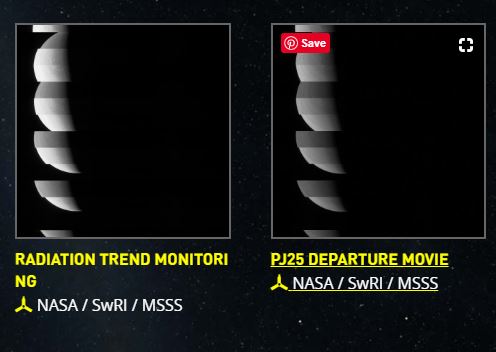NASA JUNOCAM UP TO DATE
NASA JUNOCAM UP TO DATE
WELCOME TO THE JUNOCAM COMMUNITY WHERE YOU CAN ACTIVELY PARTICIPATE IN THE MISSION! UPLOAD YOUR IMAGES OF JUPITER AND HELP US DECIDE WHAT POINTS OF INTEREST JUNOCAM WILL PHOTOGRAPH.
WELCOME TO THE JUNOCAM COMMUNITY WHERE YOU CAN ACTIVELY PARTICIPATE IN THE MISSION! UPLOAD YOUR IMAGES OF JUPITER AND HELP US DECIDE WHAT POINTS OF INTEREST JUNOCAM WILL PHOTOGRAPH.
INSTRUCTIONS FOR AMATEUR OBSERVERS
The Juno mission science team strongly encourages
mission-supporting observations from both the
professional and amateur communities.
To help us in our planning during the mission, we are
accepting imaging contributions from the amateur
community with a point of deposit on the Mission Juno
website. Image files can be uploaded onto the site,
including those from earlier in the year (e.g the epoch
around Jupiter opposition in early February). We will assess
our ability to work with the data received, organizing it
and transforming it into a form most useful for the Juno
science team.
We will accept data in any form and using any filters that
are available to each contributor.
mission-supporting observations from both the
professional and amateur communities.
To help us in our planning during the mission, we are
accepting imaging contributions from the amateur
community with a point of deposit on the Mission Juno
website. Image files can be uploaded onto the site,
including those from earlier in the year (e.g the epoch
around Jupiter opposition in early February). We will assess
our ability to work with the data received, organizing it
and transforming it into a form most useful for the Juno
science team.
We will accept data in any form and using any filters that
are available to each contributor.
We note that images that will be most valuable for us
should not be in a destructively compressed format. If at
all possible, render them in TIF or PNG (or FITS) formats
that preserve the linearity of the detector response. JPEG
or GIF formats destroy the linearity, so please avoid these.
Send us the information on who made the image, where it
was made, what date and time, and which filter was used
or whether a color camera was used.
Send us a “sharpened” image, if you wish, but we request
also, an image that has not been subject to any processing.
This will make it easier for us to use the same approach on
several different types of images during the same epoch
should not be in a destructively compressed format. If at
all possible, render them in TIF or PNG (or FITS) formats
that preserve the linearity of the detector response. JPEG
or GIF formats destroy the linearity, so please avoid these.
Send us the information on who made the image, where it
was made, what date and time, and which filter was used
or whether a color camera was used.
Send us a “sharpened” image, if you wish, but we request
also, an image that has not been subject to any processing.
This will make it easier for us to use the same approach on
several different types of images during the same epoch
MASSIVE BEAUTY
Image credit:
Image data: NASA/JPL-Caltech/SwRI/MSSS
Image data: NASA/JPL-Caltech/SwRI/MSSS
NASA’s Juno mission captured this look at the southern hemisphere of Jupiter on Feb. 17, 2020, during the spacecraft’s most recent close approach to the giant planet.
Not only is Jupiter the largest planet orbiting the Sun, it contains more than twice the amount of material of all other objects in the solar system combined — including all the planets, moons, asteroids and comets. In composition, Jupiter resembles a star, and scientists estimate that if it had been at least 80 times more massive at its formation, it could have become a type of star called a red dwarf rather than a planet.
While the universe’s most common elements, hydrogen, and helium, make up most of Jupiter’s mass, the striking clouds that are visible at the top of its atmosphere are composed mostly of ammonia and hydrogen sulfide.
This high-resolution view is a composite of four images captured by the JunoCam imager and assembled by citizen scientist Kevin M. Gill. The images were taken on Feb. 17, 2020, between 10:31 a.m. and 11:00 a.m. PST (1:31 p.m. and 2:00 p.m. EST). During that time, the spacecraft was between about 30,700 and 62,400 miles (49,500 and 100,400 kilometers) from the tops of the planet’s clouds, at altitudes between about 50 and 68 degrees South.
JunoCam's raw images are available for the public to peruse and process into image products at https://missionjuno.swri.edu/junocam/processing.
More information about Juno is at https://www.nasa.gov/juno and https://missionjuno.swri.edu.




Comments
Post a Comment